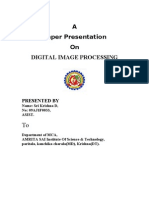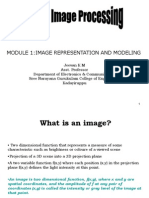Digital Image Fundamentals
Uploaded by
Vishwanath NarayananDigital Image Fundamentals
Uploaded by
Vishwanath NarayananDigital Image Processing, 2nd ed.
www.imageprocessingbook.com
A-PDF PPT TO PDF DEMO: Purchase from www.A-PDF.com to remove the watermark
Digital Image Fundamentals
One picture is worth more than ten thousand words.
2002 R. C. Gonzalez & R. E. Woods
Digital Image Processing, 2nd ed.
www.imageprocessingbook.com
What Is Digital Image Processing?
An image may be defined as a two-dimensional function, f(x, y), where x and y are spatial (plane) coordinates. The amplitude of f at any pair of coordinates (x, y) is called the intensity or gray level of the image at that point. When x, y, and the amplitude values of f are all finite, discrete quantities, we call the image a digital image. The field of digital image processing refers to processing digital images by means of a digital computer.
2002 R. C. Gonzalez & R. E. Woods
Digital Image Processing, 2nd ed.
www.imageprocessingbook.com
Digital Image
Ddigital image is composed of a finite number of elements, each of which has a particular location and value. These elements are referred to as picture elements, image elements, pels, and pixels. Unlike humans, who are limited to the visual band of the electromagnetic (EM) spectrum, imaging machines cover almost the entire EM spectrum, ranging from gamma to radio waves.
2002 R. C. Gonzalez & R. E. Woods
Digital Image Processing, 2nd ed.
www.imageprocessingbook.com
From image processing to computer vision
Low-level: both inputs and outputs are images Primitive image processing operations: noise reduction, contrast enhancement, image sharpening Mid-level: inputs are images, outputs are attributes extracted from the images (edges, contours) Segmentation, object recognition Higher-level: making sense of an ensemble of recognized objects
2002 R. C. Gonzalez & R. E. Woods
Digital Image Processing, 2nd ed.
www.imageprocessingbook.com
From image processing to computer vision: example from medical imaging (1) Low-level: both inputs and outputs are images Primitive image processing
operations: noise reduction, contrast enhancement, image sharpening Coronary angiogram
2002 R. C. Gonzalez & R. E. Woods
Digital Image Processing, 2nd ed.
www.imageprocessingbook.com
From image processing to computer vision: example from medical imaging (2)
coronary artery
Mid-level: inputs are a images, outputs are attributes extracted from the images Segmentation, object
recognition
2002 R. C. Gonzalez & R. E. Woods
Digital Image Processing, 2nd ed.
www.imageprocessingbook.com
From image processing to computer vision: example from medical imaging (3)
Higher-level: making sense of an ensemble of recognized objects Automatic volume
annotation within volume rendering
Future of full heart modeling
2002 R. C. Gonzalez & R. E. Woods
Digital Image Processing, 2nd ed.
www.imageprocessingbook.com
Components of an Image Processing System
2002 R. C. Gonzalez & R. E. Woods
Digital Image Processing, 2nd ed.
www.imageprocessingbook.com
Components of an Image Processing System
computer: in an image processing system is a general-purpose computer and can range from a PC to a supercomputer. Software: for image processing consists of specialized modules that perform specific tasks. Mass storage: Digital storage for image processing applications falls into three principal categories: (1) short term storage for use during processing, (2) on-line storage for relatively fast recall, and (3) archival storage, characterized by infrequent access. Image displays: in use today are mainly color (preferably flat screen) TV monitors. Monitors are driven by the outputs of image and graphics display cards that are an integral part of the computer system. Hardcopy: devices for recording images include laser printers, film cameras, heat-sensitive devices, inkjet units, and digital units, such as optical and CD-ROM disks. etworking: Because of the large amount of data inherent in image processing applications, the key consideration in image transmission is bandwidth.
2002 R. C. Gonzalez & R. E. Woods
Digital Image Processing, 2nd ed.
www.imageprocessingbook.com
Structure of the Human Eye
Three membranes enclose the eye: the cornea and sclera outer cover; the choroid; and the retina. The lens absorbs approximately 8% of the visible light spectrum, with relatively higher absorption at shorter wavelengths. Pattern vision is afforded by the distribution of discrete light receptors over the surface of the retina. There are two classes of receptors: cones and rods.
2002 R. C. Gonzalez & R. E. Woods
Digital Image Processing, 2nd ed.
www.imageprocessingbook.com
Structure of the Human Eye
Muscles controlling the eye rotate the eyeball until the image of an object of interest falls on the fovea. Except for blind spot region, the distribution of receptors is radially symmetric about the fovea. the fovea as a square sensor array of size 1.5 mm*1.5 mm. The density of cones in that area of the retina is approximately 150,000 elements per mm2. a charge-coupled device (CCD) imaging chip of medium resolution can have this number of elements in a receptor array no larger than 5 mm*5 mm.
2002 R. C. Gonzalez & R. E. Woods
Digital Image Processing, 2nd ed.
www.imageprocessingbook.com
Image Formation in the Eye
The shape of the lens is controlled by tension in the fibers of the ciliary body. To focus on distant objects, the controlling muscles cause the lens to be relatively flattened. Similarly, these muscles allow the lens to become thicker in order to focus on objects near the eye. The retinal image is reflected primarily in the area of the fovea. Perception then takes place by the relative excitation of light receptors, which transform radiant energy into electrical impulses that are ultimately decoded by the brain.
2002 R. C. Gonzalez & R. E. Woods
Digital Image Processing, 2nd ed.
www.imageprocessingbook.com
Brightness Adaptation and Discrimination
The range of light intensity levels to which the human visual system can adapt is enormouson the order of 1010 from the scotopic threshold to the glare limit. Experimental evidence indicates that subjective brightness (intensity as perceived by the human visual system) is a logarithmic function of the light intensity incident on the eye. The essential point in interpreting the impressive dynamic range depicted in the figure that the visual system cannot operate over such a range simultaneously. Rather, it accomplishes this large variation by changes in its overall sensitivity, a phenomenon known as brightness adaptation.
2002 R. C. Gonzalez & R. E. Woods
Digital Image Processing, 2nd ed.
www.imageprocessingbook.com
Brightness Adaptation and Discrimination
A classic experiment used to determine the capability of the human visual system for brightness discrimination consists of having a subject look at a flat, uniformly illuminated area large enough to occupy the entire field of view. The quantity Ic/I where Ic is the increment of illumination discriminable 50% of the time with background illumination I, is called the Weber ratio. A small value of Ic/I means that a small percentage change in intensity is discriminable.This represents good brightness discrimination. Conversely, a large value of Ic/I means that a large percentage change in intensity is required.
2002 R. C. Gonzalez & R. E. Woods
Digital Image Processing, 2nd ed.
www.imageprocessingbook.com
Brightness Adaptation and Discrimination
A plot of as a function of log I has the general shape shown in Fig. 2.6.This curve shows that brightness discrimination is poor (the Weber ratio is large) at low levels of illumination, and it improves significantly (the Weber ratio decreases) as background illumination increases.The two branches in the curve reflect the fact that at low levels of illumination vision is carried out by activity of the rods, whereas at high levels (showing better discrimination) vision is the function of 2002 R. C. Gonzalez & R. E. Woods cones.
Digital Image Processing, 2nd ed.
www.imageprocessingbook.com
Brightness Adaptation and Discrimination
2002 R. C. Gonzalez & R. E. Woods
Digital Image Processing, 2nd ed.
www.imageprocessingbook.com
Optical Illusions
2002 R. C. Gonzalez & R. E. Woods
Digital Image Processing, 2nd ed.
www.imageprocessingbook.com
Optical Illusions
2002 R. C. Gonzalez & R. E. Woods
Digital Image Processing, 2nd ed.
www.imageprocessingbook.com
Light and the Electromagnetic Spectrum
2002 R. C. Gonzalez & R. E. Woods
Digital Image Processing, 2nd ed.
www.imageprocessingbook.com
Light and the Electromagnetic Spectrum
2002 R. C. Gonzalez & R. E. Woods
Digital Image Processing, 2nd ed.
www.imageprocessingbook.com
Image Sensing and Acquisition
The types of images in which we are interested are generated by the combination of an illumination source and the reflection or absorption of energy from that source by the elements of the scene being imaged. Incoming energy is transformed into a voltage by the combination of input electrical power and sensor material that is responsive to the particular type of energy being detected. The output voltage waveform is the response of the sensor(s), and a digital quantity is obtained from each sensor digitizing its response.
2002 R. C. Gonzalez & R. E. Woods
Digital Image Processing, 2nd ed.
www.imageprocessingbook.com
Image Acquisition Using a Single Sensor
The single sensor is mounted on a lead screw that provides motion in the perpendicular direction. Since mechanical motion can be controlled with high precision, this method is an inexpensive (but slow) way to obtain high-resolution images.
2002 R. C. Gonzalez & R. E. Woods
Digital Image Processing, 2nd ed.
www.imageprocessingbook.com
Image Acquisition Using Sensor Strips
Sensor Strips: This is the type of
arrangement used in most flat bed scanners. Sensor strips mounted in a ring configuration are used in medical an industrial imaging to obtain cross-sectional (slice) images of 3-D objects. the output of the sensors must be processed by reconstruction algorithms whose objective is to transform the sensed data into meaningful cross sectional images.
2002 R. C. Gonzalez & R. E. Woods
Digital Image Processing, 2nd ed.
www.imageprocessingbook.com
Image Acquisition Using Sensor Arrays:
This is also the predominant arrangement found in digital cameras. The response of each sensor is proportional to the integral of the light energy projected onto the surface of the sensor. The sensor array, which is coincident with the focal plane, produces outputs proportional to the integral of the light received at each sensor. Digital and analog circuitry sweep these outputs and convert them to a video signal, which is then digitized by another section of the imaging system.
2002 R. C. Gonzalez & R. E. Woods
Digital Image Processing, 2nd ed.
www.imageprocessingbook.com
Image Acquisition Using Sensor Arrays:
2002 R. C. Gonzalez & R. E. Woods
Digital Image Processing, 2nd ed.
www.imageprocessingbook.com
A Simple Image Formation Model:
we shall denote images by two-dimensional functions of the form f(x, y). f(x, y) must be nonzero and finite; that is: The function f(x, y) may be characterized by two components: (1) the amount of source illumination incident on the scene being viewed, and (2) the amount of illumination reflected by the objects in the scene. Appropriately, these are called the illumination and reflectance components and are denoted by i(x, y) and r(x, y), respectively. The two functions combine as a product to form f(x, y):
2002 R. C. Gonzalez & R. E. Woods
Digital Image Processing, 2nd ed.
www.imageprocessingbook.com
Image Sampling and Quantization
To create a digital image, we need to convert the continuous sensed data into digital form. This involves two processes: sampling and quantization. Digitizing the coordinate values is called sampling. Digitizing the amplitude values is called quantization.
2002 R. C. Gonzalez & R. E. Woods
Digital Image Processing, 2nd ed.
www.imageprocessingbook.com
Image Sampling and Quantization
The quality of a digital image is determined to a large degree by the number of samples and discrete gray levels used in sampling and quantization.
2002 R. C. Gonzalez & R. E. Woods
Digital Image Processing, 2nd ed.
www.imageprocessingbook.com
Representing Digital Images
The notation introduced allows us to write the complete Mx digital image in the following compact matrix form:
2002 R. C. Gonzalez & R. E. Woods
Digital Image Processing, 2nd ed.
www.imageprocessingbook.com
Representing Digital Images
This digitization process requires decisions about values for M, , and for the number, L, of discrete gray levels allowed for each pixel. Due to processing, storage, and sampling hardware considerations, the number of gray levels typically is an integer power of 2: L=2k We assume that the discrete levels are equally spaced and that they are integers in the interval [0, L-1]. Sometimes the range of values spanned by the gray scale is called the dynamic range of an image. The number, b, of bits required to store a digitized image is:
2002 R. C. Gonzalez & R. E. Woods
Digital Image Processing, 2nd ed.
www.imageprocessingbook.com
Spatial and Gray-Level Resolution
Sampling is the principal factor determining the spatial resolution of an image. Basically, spatial resolution is the smallest discernible detail in an image.
2002 R. C. Gonzalez & R. E. Woods
Digital Image Processing, 2nd ed.
www.imageprocessingbook.com
Spatial and Gray-Level Resolution
A widely used definition of resolution is simply the smallest number of discernible line pairs per unit distance; for example, 100 line pairs per millimeter.
2002 R. C. Gonzalez & R. E. Woods
Digital Image Processing, 2nd ed.
www.imageprocessingbook.com
Spatial and Gray-Level Resolution
Gray-level resolution similarly refers to the smallest discernible change in gray level
2002 R. C. Gonzalez & R. E. Woods
Digital Image Processing, 2nd ed.
www.imageprocessingbook.com
Spatial and Gray-Level Resolution
Ridge-like structures in areas of smooth gray levels. This effect, caused
by the use of an insufficient number of gray levels in smooth areas of a digital image, is called false contouring.
2002 R. C. Gonzalez & R. E. Woods
Digital Image Processing, 2nd ed.
www.imageprocessingbook.com
Spatial and Gray-Level Resolution
2002 R. C. Gonzalez & R. E. Woods
Digital Image Processing, 2nd ed.
www.imageprocessingbook.com
isopreference curves
Sets of these three types of images were generated by varying and k, and observers were then asked to rank them according to their subjective quality. Results were summarized in the form of so-called isopreference curves in the Nk-plane. Points lying on an isopreference curve correspond to images of equal subjective quality. The key point of interest in the context of the present discussion is that isopreference curves tend to become more vertical as the detail in the image increases. This result suggests that for images with a large amount of detail only a few gray levels may be needed.
2002 R. C. Gonzalez & R. E. Woods
Digital Image Processing, 2nd ed.
www.imageprocessingbook.com
Image Interpolation
Fundamentally, Interpolation is the process of using data to estimate values at unknown locations. Interpolation is a basic tool used zooming, shrinking, rotating, and geometric corrections. The simplest method of interpolation is nearest neighbor interpolation where the intensity of each location assigns the intensity of its nearest neighbor. Although nearest neighbor interpolation is fast, it has the undesirable feature that it produces a checkerboard effect that is particularly objectionable at high factors of magnification. Also, it has the tendency to produce undesirable artifacts, such as a severe distortion of straight edges and
2002 R. C. Gonzalez & R. E. Woods
Digital Image Processing, 2nd ed.
www.imageprocessingbook.com
Image Interpolation
A more suitable approach is bilinear interpolation, in which we use the four nearest neighbors to estimate the intensity at a given location. Let (x, y) denote the coordinates of a point in the zoomed image (think of it as a point on the grid described previously), and let v(x, y) denote the gray level assigned to it. For bilinear interpolation, the assigned gray level is given by:
v(x, y) = a x + b y + c xy + d
where the four coefficients are determined from the four equations in four unknowns that can be written using the four nearest neighbors of point (x, y).
2002 R. C. Gonzalez & R. E. Woods
Digital Image Processing, 2nd ed.
www.imageprocessingbook.com
Image Interpolation- bilinear
-Assuming u and v are integer parts of X and Y, respectively, bilinear interpolation is defined by:
2002 R. C. Gonzalez & R. E. Woods
Digital Image Processing, 2nd ed.
www.imageprocessingbook.com
Image Interpolation- bicubic
The next level of interpolation is bicubic interpolation, which involves the sixteen nearest neighbors of a point. The intensity value assigned to point (x,y) is obtained using the equation: 3 3
v( x, y ) = aij x i y j
i =0 j =0
where the sixteen coefficients are determined from the sixteen equations in sixteen unknowns that can be written using the sixteen nearest neighbors of point (x,y).
2002 R. C. Gonzalez & R. E. Woods
Digital Image Processing, 2nd ed.
www.imageprocessingbook.com
Image Interpolation
2002 R. C. Gonzalez & R. E. Woods
Digital Image Processing, 2nd ed.
www.imageprocessingbook.com
Some Basic Relationships Between Pixels
eighbors of a Pixel: A pixel p at coordinates (x, y) has four horizontal and vertical neighbors whose coordinates are given by This set of pixels, called the 4-neighbors of p, is denoted by The four diagonal neighbors of p have coordinates
4(p)
and are denoted by D(p). These points, together with the 4-neighbors, are called the 8-neighbors of p, denoted by 8(p).
2002 R. C. Gonzalez & R. E. Woods
Digital Image Processing, 2nd ed.
www.imageprocessingbook.com
Adjacency, Connectivity, Regions, and Boundaries
Connectivity between pixels is a fundamental concept that simplifies the definition of numerous digital image concepts, such as regions and boundaries. To establish if two pixels are connected, it must be determined if they are neighbors and if their gray levels satisfy a specified criterion of similarity (say, if their gray levels are equal). Let V be the set of gray-level values used to define adjacency.
2002 R. C. Gonzalez & R. E. Woods
Digital Image Processing, 2nd ed.
www.imageprocessingbook.com
Adjacency, Connectivity, Regions, and Boundaries
We consider three types of adjacency: (a) 4-adjacency. Two pixels p and q with values from V are 4-adjacent if q is in the set 4(p). (b) 8-adjacency. Two pixels p and q with values from V are 8-adjacent if q is in the set 8(p). (c) m-adjacency (mixed adjacency). Two pixels p and q with values from V are m-adjacent if (i) q is in 4(p), or (ii) q is in D(p) and the set 4(p) 4(q) has no pixels whose values are from V.
2002 R. C. Gonzalez & R. E. Woods
Digital Image Processing, 2nd ed.
www.imageprocessingbook.com
Adjacency, Connectivity, Regions, and Boundaries
Two image subsets S1 and S2 are adjacent if some pixel in S1 is adjacent to some pixel in S2. It is understood here and in the following definitions that adjacent means 4-, 8-, or m-adjacent. Normally, when we refer to a region, we are referring to a subset of an image, and any pixels in the boundary of the region that happen to coincide with the border of the image are included implicitly as part of the region boundary. Conceptually, it is helpful to think of edges as intensity discontinuities and boundaries as closed paths.
2002 R. C. Gonzalez & R. E. Woods
Digital Image Processing, 2nd ed.
www.imageprocessingbook.com
Distance Measures
For pixels p, q, and z, with coordinates (x, y), (s, t), and (v, w), respectively, D is a distance function or metric if
The Euclidean distance between p and q is defined as:
2002 R. C. Gonzalez & R. E. Woods
Digital Image Processing, 2nd ed.
www.imageprocessingbook.com
Distance Measures
The D4 distance between p and q is defined as:
In this case, the pixels having a D4 distance from (x, y) less than or equal to some value r form a diamond centered at (x, y). For example, the pixels with D4 distance 2 from (x, y) (the center point) form the following contours of constant distance:
The pixels with D4=1 are the 4-neighbors of (x, y).
2002 R. C. Gonzalez & R. E. Woods
Digital Image Processing, 2nd ed.
www.imageprocessingbook.com
Distance Measures
The D8 distance (also called chessboard distance) between p and q is defined as
For example, the pixels with D8 distance 2 from (x, y) (the center point) form the following contours of constant distance:
The pixels with D8=1 are the 8-neighbors of (x, y).
2002 R. C. Gonzalez & R. E. Woods
You might also like
- Image Sensing and Acquisition: Chapter 2: Digital Image Fundamentals75% (4)Image Sensing and Acquisition: Chapter 2: Digital Image Fundamentals14 pages
- AMME4710 Chap2 DigitalImageFundamentalsNo ratings yetAMME4710 Chap2 DigitalImageFundamentals64 pages
- Unit-I Introduction To Image ProcessingNo ratings yetUnit-I Introduction To Image Processing23 pages
- Fundamental Steps of Digital Image ProcessingNo ratings yetFundamental Steps of Digital Image Processing30 pages
- Advance Digital Image Processing Books: Text/References: D.K.VishwakarmaNo ratings yetAdvance Digital Image Processing Books: Text/References: D.K.Vishwakarma38 pages
- Engr. Dr. Ahmed Sohaib Department of Computer Engineering Kfueit Advanced Digital Image Processing Fall 2018No ratings yetEngr. Dr. Ahmed Sohaib Department of Computer Engineering Kfueit Advanced Digital Image Processing Fall 201841 pages
- Module 1:image Representation and ModelingNo ratings yetModule 1:image Representation and Modeling48 pages
- Image Segmentation: © 2002 R. C. Gonzalez & R. E. WoodsNo ratings yetImage Segmentation: © 2002 R. C. Gonzalez & R. E. Woods75 pages
- What-is-meant-by-digital-image-processing (1)No ratings yetWhat-is-meant-by-digital-image-processing (1)10 pages
- Motivation For Ip: Rakesh Soni M.E. (CSE) Assistant Professor, PietNo ratings yetMotivation For Ip: Rakesh Soni M.E. (CSE) Assistant Professor, Piet87 pages
- Unit-I: Digital Image Fundamentals & Image TransformsNo ratings yetUnit-I: Digital Image Fundamentals & Image Transforms70 pages
- Image Processing: By: Prof. Monika ShahNo ratings yetImage Processing: By: Prof. Monika Shah57 pages
- @vtucode - in 21CS63 Module 4 PDF 2021 SchemeNo ratings yet@vtucode - in 21CS63 Module 4 PDF 2021 Scheme46 pages
- 21 AD6703 UNIT I DIGITAL IMAGE FUNDAMENTALS[1]No ratings yet21 AD6703 UNIT I DIGITAL IMAGE FUNDAMENTALS[1]24 pages
- Computer Stereo Vision: Exploring Depth Perception in Computer VisionFrom EverandComputer Stereo Vision: Exploring Depth Perception in Computer VisionNo ratings yet
- Mentor Graphics Corporation, Using DesignChecker With SystemVerilog-VHDL Assistant, Release v2018.2No ratings yetMentor Graphics Corporation, Using DesignChecker With SystemVerilog-VHDL Assistant, Release v2018.258 pages
- Course 6 - Refrigerator Installation - VC150SDDNo ratings yetCourse 6 - Refrigerator Installation - VC150SDD11 pages
- Onward Journey Ticket Details: ConfirmedNo ratings yetOnward Journey Ticket Details: Confirmed2 pages
- DI-C001-1339A Combined Upgrade Instructions 6135 - 6753 To 6742 PDFNo ratings yetDI-C001-1339A Combined Upgrade Instructions 6135 - 6753 To 6742 PDF36 pages
- Letter To District Collectors On Data Discrepancies in BOP APPNo ratings yetLetter To District Collectors On Data Discrepancies in BOP APP3 pages
- Project in Electronics and Circuit Design 1No ratings yetProject in Electronics and Circuit Design 114 pages
- Journal of Robotics - 2021 - Neira - Review On Unmanned Underwater Robotics Structure Designs Materials SensorsNo ratings yetJournal of Robotics - 2021 - Neira - Review On Unmanned Underwater Robotics Structure Designs Materials Sensors26 pages
- DIFFERENTTYPESOFWINGLETSANDTHEIRCORRESPONDINGVORTICESNo ratings yetDIFFERENTTYPESOFWINGLETSANDTHEIRCORRESPONDINGVORTICES23 pages
- Image Sensing and Acquisition: Chapter 2: Digital Image FundamentalsImage Sensing and Acquisition: Chapter 2: Digital Image Fundamentals
- Advance Digital Image Processing Books: Text/References: D.K.VishwakarmaAdvance Digital Image Processing Books: Text/References: D.K.Vishwakarma
- Engr. Dr. Ahmed Sohaib Department of Computer Engineering Kfueit Advanced Digital Image Processing Fall 2018Engr. Dr. Ahmed Sohaib Department of Computer Engineering Kfueit Advanced Digital Image Processing Fall 2018
- Image Segmentation: © 2002 R. C. Gonzalez & R. E. WoodsImage Segmentation: © 2002 R. C. Gonzalez & R. E. Woods
- Motivation For Ip: Rakesh Soni M.E. (CSE) Assistant Professor, PietMotivation For Ip: Rakesh Soni M.E. (CSE) Assistant Professor, Piet
- Unit-I: Digital Image Fundamentals & Image TransformsUnit-I: Digital Image Fundamentals & Image Transforms
- Computer Stereo Vision: Exploring Depth Perception in Computer VisionFrom EverandComputer Stereo Vision: Exploring Depth Perception in Computer Vision
- Mentor Graphics Corporation, Using DesignChecker With SystemVerilog-VHDL Assistant, Release v2018.2Mentor Graphics Corporation, Using DesignChecker With SystemVerilog-VHDL Assistant, Release v2018.2
- DI-C001-1339A Combined Upgrade Instructions 6135 - 6753 To 6742 PDFDI-C001-1339A Combined Upgrade Instructions 6135 - 6753 To 6742 PDF
- Letter To District Collectors On Data Discrepancies in BOP APPLetter To District Collectors On Data Discrepancies in BOP APP
- Journal of Robotics - 2021 - Neira - Review On Unmanned Underwater Robotics Structure Designs Materials SensorsJournal of Robotics - 2021 - Neira - Review On Unmanned Underwater Robotics Structure Designs Materials Sensors
- DIFFERENTTYPESOFWINGLETSANDTHEIRCORRESPONDINGVORTICESDIFFERENTTYPESOFWINGLETSANDTHEIRCORRESPONDINGVORTICES

























































































